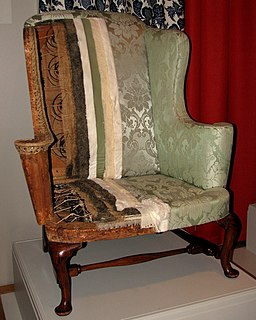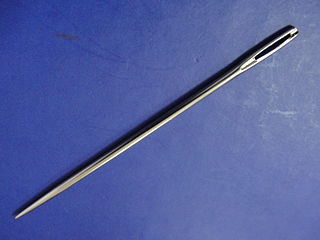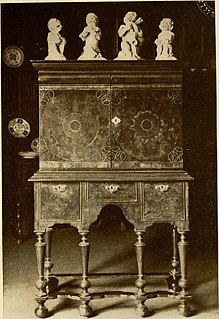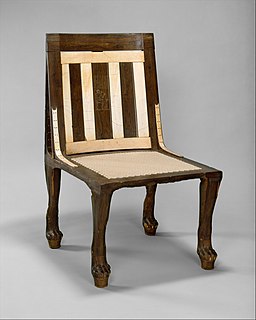
Furniture refers to movable objects intended to support various human activities such as seating, eating (tables), and sleeping. Furniture is also used to hold objects at a convenient height for work, or to store things. Furniture can be a product of design and is considered a form of decorative art. In addition to furniture's functional role, it can serve a symbolic or religious purpose. It can be made from many materials, including metal, plastic, and wood. Furniture can be made using a variety of woodworking joints which often reflect the local culture.

One of the basic pieces of furniture, a chair is a type of seat. Its primary features are two pieces of a durable material, attached as back and seat to one another at a 90° or slightly greater angle, with usually the four corners of the horizontal seat attached in turn to four legs—or other parts of the seat's underside attached to three legs or to a shaft about which a four-arm turnstile on rollers can turn—strong enough to support the weight of a person who sits on the seat and leans against the vertical back. The legs are typically high enough for the seated person's thighs and knees to form a 90° or lesser angle. Used in a number of rooms in homes, in schools and offices, and in various other workplaces, chairs may be made of wood, metal, or synthetic materials, and either the seat alone or the entire chair may be padded or upholstered in various colors and fabrics.

Upholstery is the work of providing furniture, especially seats, with padding, springs, webbing, and fabric or leather covers. The word also refers to the materials used to upholster something.

A sewing needle, used for hand-sewing, is a long slender tool with a pointed tip at one end and a hole at the other. The earliest needles were made of bone or wood; modern needles are manufactured from high carbon steel wire and are nickel- or 18K gold-plated for corrosion resistance. High quality embroidery needles are plated with two-thirds platinum and one-third titanium alloy. Traditionally, needles have been kept in needle books or needlecases which have become objects of adornment. Sewing needles may also be kept in an étui, a small box that held needles and other items such as scissors, pencils and tweezers.
Chairs are known from Ancient Egypt and have been widespread in the Western world from the Greeks and Romans onwards. They were in common use in China from the twelfth century, and were used by the Aztecs.

A table is an item of furniture with a flat top and one or more legs, used as a surface for working at, eating from or on which to place things. Some common types of table are the dining room table, which is used for seated persons to eat meals; the coffee table, which is a low table used in living rooms to display items or serve refreshments; and the bedside table, which is used to place an alarm clock and a lamp. There are also a range of specialized types of tables, such as drafting tables, used for doing architectural drawings, and sewing tables.

A chest is a form of furniture typically of a rectangular structure with four walls and a removable lid, for storage. The interior space may be subdivided. The early uses of an antique chest or coffer included storage of fine cloth, weapons, foods and valuable items. It is a box with a hinged lid that can safeguard personal items. Some chests are equipped with locking mechanisms or a metal band that a lock can be secured on. In Webster’s Dictionary 1988 version, a chest is defined as a “a box with a lid and often, a lock, for storing or shipping things” or as “a cabinet as for holding medical supplies, toiletries, etc.”

A footstool is a piece of furniture or a support used to elevate the foot. There are two main types of footstool, which can be loosely categorized into those designed for comfort and those designed for function.

Wicker is a technique for making products woven from any one of a variety of pliable plant materials, a generic name for the materials used in such manufacture, and a term for the items so produced. The word wicker is believed to be of Scandinavian origin: vika, which means to bend in Swedish, and vikker meaning willow. Wicker is traditionally made of material of plant origin, such as willow, rattan, reed, and bamboo, but synthetic fibers are now also used. Wicker is light yet sturdy, making it suitable for items that will be moved often like porch and patio furniture. Rushwork and wickerwork are terms used in England. A typical braiding pattern is called Wiener Geflecht, Viennese Braiding, as it was invented in 18th century Vienna and later most prominently used with the Thonet coffeehouse chair.

A Windsor chair is a chair built with a solid wooden seat into which the chair-back and legs are round-tenoned, or pushed into drilled holes, in contrast to standard chairs. The seats of Windsor chairs were often carved into a shallow dish or saddle shape for comfort. Traditionally, the legs and uprights were usually turned on a pole lathe. The back and sometimes the arm pieces are formed from steam bent pieces of wood.

Artek is a Finnish furniture company. It was founded in December 1935 by architect Alvar Aalto and his wife Aino Aalto, visual arts promoter Maire Gullichsen and art historian Nils-Gustav Hahl. The founders chose a non-Finnish name: the neologism Artek was meant to manifest the desire to combine art and technology. This echoed a main idea of the International Style movement, especially the Bauhaus, to emphasize the technical expertise in production and quality of materials, instead of historical-based, eclectic or frivolous ornamentation.

A folding chair is a type of folding furniture, a light, portable chair that folds flat or to a smaller size, and can be stored in a stack, in a row, or on a cart.

The forms of Chinese furniture evolved along three distinct lineages which dates back to 1000 BC, based on frame and panel, yoke and rack and bamboo construction techniques. Chinese home furniture evolved independently of Western furniture into many similar forms including chairs, tables, stools, cupboards, cabinets, beds and sofas. Until about the 10th century CE the Chinese sat on mats or low platforms using low tables, in typical Asian style, but then gradually moved to using high tables with chairs.

A close stool was an early type of portable toilet, made in the shape of a cabinet or box at sitting height with an opening in the top. The external structure contained a pewter or earthenware chamberpot to receive the user's excrement and urine when they sat on it; this was normally covered (closed) by a folding lid. "Stool" has two relevant meanings: as a type of seat and as human feces. Close stools were used from the Middle Ages until the introduction of the indoor flush toilet.

A bed base, sometimes called a foundation, is the part of a bed that supports the mattress. The bed base can itself be held in place and framed by the bedstead. In the United States, box-spring bed bases are very common. In Europe, sprung slats are much more common.

Danish modern is a style of minimalist furniture and housewares from Denmark associated with the Danish design movement. In the 1920s, Kaare Klint embraced the principles of Bauhaus modernism in furniture design, creating clean, pure lines based on an understanding of classical furniture craftsmanship coupled with careful research into materials, proportions and the requirements of the human body. With designers such as Arne Jacobsen and Hans Wegner and associated cabinetmakers, Danish furniture thrived from the 1940s to the 1960s. Adopting mass-production techniques and concentrating on form rather than just function, Finn Juhl contributed to the style's success. Danish housewares adopting a similar minimalist design such as cutlery and trays of teak and stainless steel and dinnerware such as those produced in Denmark for Dansk in its early years, expanded the Danish modern aesthetic beyond furniture.

A stool is one of the earliest forms of seat furniture. It bears many similarities to a chair. It consists of a single seat, for one person, without back or armrests, on a base of a stool there are either one, two, three or four legs. A stool is generally distinguished from chairs by their lack of arms and a back. Variants exist with one, two or five legs and these various stools are referred to by some people as "backless chairs". Some modern stools have backs. Folding stools can become flat, typically by rotating the seat to be parallel with fold-up legs.

Ancient furniture was made of many different materials, including reeds, wood, stone, metals, straws, and ivory. Some civilizations inlay or carved images of mythological creatures or constellations carved into their furniture. The chairs would be stylized with metals, finials, inlays, or upholstery. It was a common practice for the legs of furniture to be shaped like animal legs and use mortise and tenon joints. Lacquerware and Ivory carving were also common. Throughout the ancient world inlay were common. Metals such as bronze or gold. Sometimes furniture would be inlaid into a certain shape. For example, the game Mehen was played on a table inlaid into the shape of a snake. Inlays were also used to ornament shapes.

What later came to be known as the William and Mary style is a furniture design common from 1700 to 1725 in the Netherlands, the Kingdom of England, the Kingdom of Scotland, and later, in England's American colonies. It was a transitional style between Mannerist furniture and Queen Anne furniture. Sturdy, emphasizing both straight lines and curves, and featuring elaborate carving and woodturning, the style was one of the first to imitate Asian design elements such as japanning.

The Chair of Reniseneb is an Egyptian wooden chair dated to the 15th century BC. The chair, currently on display at the Metropolitan Museum of Art, belonged to the Egyptian scribe Reniseneb.



















